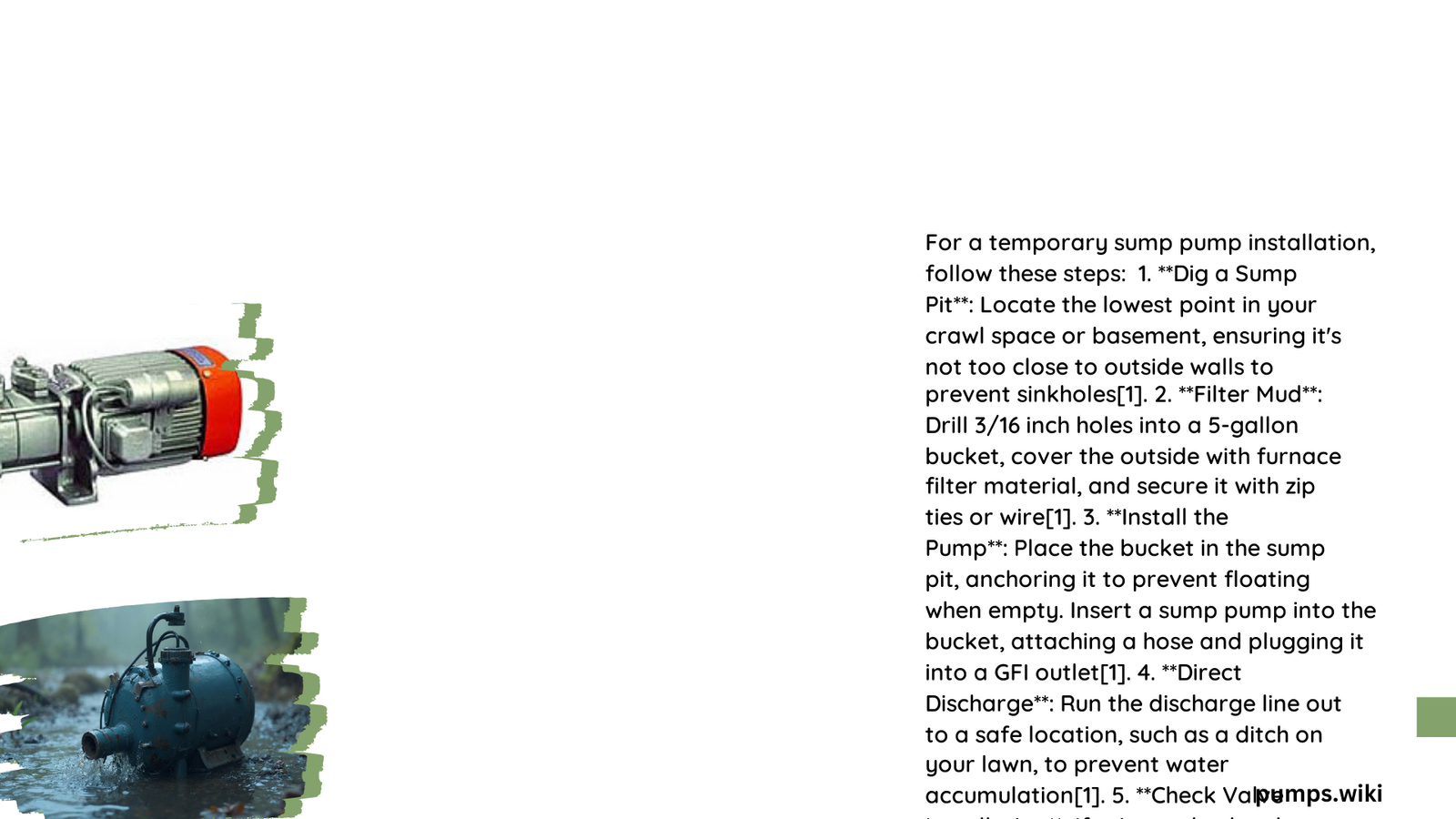Temporary sump pump installation is a crucial process for managing water in basements or crawl spaces during emergencies or short-term flooding situations. This guide provides step-by-step instructions for installing a portable sump pump, including necessary tools, installation steps, discharge options, and cost considerations. By following these guidelines, homeowners can effectively protect their property from water damage during unexpected flooding events.
What Tools and Materials Are Needed for Temporary Sump Pump Installation?
Before beginning the installation process, gather the following tools and materials:
- Drill with a 3/16-inch bit
- Bucket or wet/dry vacuum for water removal
- PVC primer and cement
- Hacksaw
- Check valve
- Adjustable pliers
- Rubber coupling boot
- Adjustable pipe wrench
- Zip ties
- Gloves
- Rags or towels
- 1.5\” or 2\” Schedule 40 PVC pipe (depending on pump’s discharge size)
- PVC discharge hose (typically 1.5\” or 2\” diameter)
- Float switch (if not included with the pump)
- GFCI outlet or battery backup system
How to Install a Temporary Sump Pump?

Follow these steps for a successful temporary sump pump installation:
- Choose the Location:
- Install the pump in the lowest point of the basement for effective water collection.
-
Ensure proximity to a GFCI outlet or have a battery backup system ready.
-
Prepare the Site:
- For concrete floors, use a jackhammer or sledgehammer to break through.
- Dig a hole slightly larger and deeper than the sump pump basin.
-
Add 2-3 inches of gravel to the bottom of the hole.
-
Measure and Cut PVC Pipe:
- Measure from the pump’s discharge to the exit point (typically 62 inches or more).
- Cut PVC pipe slightly longer than measured length.
-
Deburr cut edges to prevent leaks.
-
Attach Adapter to PVC Pipe:
-
Use PVC primer and cement to secure the male-threaded adapter.
-
Install Check Valve:
-
Attach the check valve to the discharge pipe, ensuring it’s not overtightened.
-
Drill Weep Hole:
-
Create a 3/16-inch weep hole between the pump and check valve to prevent air locking.
-
Install Pump and Discharge Pipe:
- Lower the pump into the pit, ensuring it’s level and the float switch can move freely.
-
Connect and secure the discharge pipe to the pump.
-
Test the System:
- Connect the pump to a power source.
- Test by partially filling the pit with water to ensure automatic operation.
What Are the Temporary Sump Pump Discharge Options?
Consider the following discharge options for your temporary sump pump:
Recommended Distances and Fittings
- Ensure the discharge hose extends at least 10 feet from the house foundation.
- Use 90-degree elbows and straight couplers to direct water flow.
- Secure fittings with PVC cement for a watertight seal.
Environmental Impacts
- Direct Discharge:
- Can be eco-friendly if done correctly.
-
May require local permits and adherence to regulations.
-
Lawn Discharge:
-
Effective but may cause water accumulation and erosion.
-
French Drain:
- Environmentally friendly option.
- Disperses water over a larger area.
What Are Some Emergency Sump Pump Installation Tips?
Keep these tips in mind for emergency installations:
Power Source Requirements
- Ensure a fully charged, compatible battery backup system.
- Typical systems should run the pump for several hours during outages.
Optimal Pump Placement
- Always position the pump at the basement’s lowest point for efficient water collection.
Common Challenges
- Power Outages:
-
Use a reliable battery backup to maintain pump operation.
-
Clogged Discharge Pipes:
- Regularly inspect and clean pipes to ensure proper water flow.
What Are the Costs Associated with Temporary Sump Pump Installation?
Consider the following cost factors:
Portable Sump Pump Costs
- Average prices range from $100 to $500.
- Cost varies based on horsepower and features (e.g., float switch, battery backup).
Necessary Accessories
| Accessory | Estimated Cost |
|---|---|
| Hoses and Clamps | $50 – $100 |
| Check Valve and Fittings | $20 – $50 |
Estimated Time for Setup
- Dry Conditions: 2-4 hours
- Heavy Rain or Wet Conditions: 4-6 hours
By following this comprehensive guide, homeowners can effectively install a temporary sump pump to protect their property during unexpected flooding events. Remember to always prioritize safety and consult with a professional if you’re unsure about any aspect of the installation process.
References:
1. https://www.sumppumpsdirect.com/stories/80-How-To-Install-A-Primary-Sump-Pump.html
2. https://www.youtube.com/watch?v=b7LJKqASe8s
3. https://zoellerathome.com/2021/11/30/sump-pump-installation-guide/
